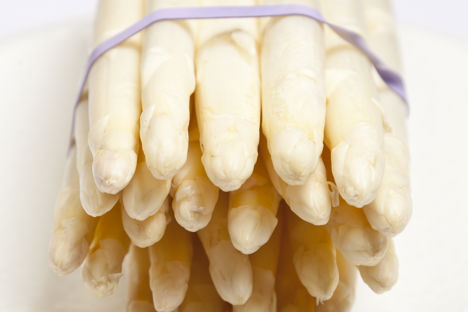White asparagus is white because it is grown without being exposed to light, preventing photosynthesis and therefore the production of chlorophyll. As it begins to grow, soil is piled onto the seedling to keep it in the dark – a very labour intensive process which explains the pricetag on this highly revered spring vegetable. Part of the lily family, white asparagus is nowhere near as popular in the UK as the green variety. However, in Germany it is eaten in abundance when in season, with the average German eating two kilograms a year.
In the UK, white asparagus is grown in the the Evesham Vale area in Worcestershire but the majority of fresh white asparagus comes from the Loire Valley in France and Germany. It is graded by size with the thickest spears being highly prized and the most expensive. White asparagus has been trialled in supermarkets in recent years but the best quality will be found at farmers’ markets or organic supermarkets during its season of April to June.
White asparagus is a very healthy vegetable, containing only twenty calories per 100g and no fat at all. It is rich in vitamin C, folic acid and antioxidants, and said to be beneficial for a healthy heart.
How to cook white asparagus
White asparagus has a thick outer skin that, unlike green asparagus, must be peeled before using as it is too stringy to eat. The base should also be removed as it is too woody to chew. The most traditional way of cooking white asparagus is in an emulsion of water, butter, lemon juice and salt, which is brought to the boil and the asparagus added and gently simmered for anything between eight and thirty minutes, depending on the thickness of the spears. It is best to let the asparagus cool in this liquid to retain flavour and moisture.
Steaming is another popular cooking method, in which all of the asparagus' flavour is retained – a much healthier alternative to cooking in butter.
Roasting and grilling are both good ways to achieve a caramelised flavour from white asparagus and (weather permitting) you could even cook it on the barbecue to impart a lovely smokiness.
Don't bin those bases either – cook them down with stock and use to make a velvety soup or creamy purée to accompany a main course.
White asparagus also lends itself well to being pickled. You will often find jars of it adorning the shelves in supermarkets all over Europe, but it is easy enough to do at home if you have any leftovers.
What white asparagus goes with
White asparagus has a delicate flavour with a slight bitterness and is able to hold its own even with strong flavoured meats such as beef and duck but also complements more subtle flavours like rabbit and chicken. Try Alyn Williams’ Beef sirloin with white asparagus and ale or Adam Gray’s Roast duck breast with white asparagus, pea cream and beer gravy.
Olive oil, butter and other fats are often paired with white asparagus to counteract its bitterness, with hollandaise sauce being a traditional accompaniment. Strong cheese such as Parmesan, Taleggio and cheddar also work really well; try a white asparagus gratin sprinkled with crunchy breadcrumbs or adding white asparagus to a cheesy pizza with salty prosciutto (and top with truffle if you feel like a real treat).
Get in touch
Please sign in or register to send a comment to Great British Chefs.



